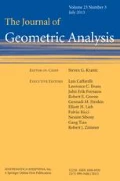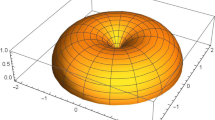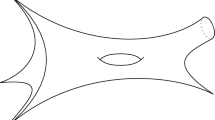Abstract
We define Cayley structures as a field of Cayley’s ruled cubic surfaces over a four dimensional manifold and motivate their study by showing their similarity to indefinite conformal structures and their link to differential equations and the theory of integrable systems. In particular, for Cayley structures an extension of certain notions defined for indefinite conformal structures in dimension four are introduced, e.g., half-flatness, existence of a null foliation, ultra-half-flatness, an associated pair of second order ODEs, and a dispersionless Lax pair. After solving the equivalence problem we obtain the fundamental invariants, find the local generality of several classes of Cayley structures and give examples.
Similar content being viewed by others
Notes
Since the integral manifolds of \(I_{\mathsf {cong}}\) are referred to as null surfaces of M, we used the subscript \(\mathsf {null}\) for the 3-fold S.
References
Akivis, M. A., Goldberg, V. V.: Conformal differential geometry and its generalizations. Pure and Applied Mathematics (New York). John Wiley & Sons Inc., New York. A Wiley-Interscience Publication (1996)
Anderson, I., Nie, Z., Nurowski, P.: Non-rigid parabolic geometries of Monge type. Adv. Math. 277, 24–55 (2015)
Baston, R .J.: Almost Hermitian symmetric manifolds. I. Local twistor theory. Duke Math. J. 63(1), 81–112 (1991)
Bailey, T.N., Eastwood, M.G.: Complex paraconformal manifolds—their differential geometry and twistor theory. Forum Math. 3(1), 61–103 (1991)
Belgun, F.A.: On the Weyl tensor of a self-dual complex 4-manifold. Trans. Am. Math. Soc. 356(3), 853–880 (2004)
Bryant, R.L., Griffiths, P., Grossman, D.: Exterior differential systems and Euler-Lagrange partial differential equations. Chicago Lectures in Mathematics. University of Chicago Press, Chicago, IL (2003)
Bryant, R.L., Griffiths, P., Hsu, L.: Toward a geometry of differential equations. In Geometry, topology, & physics, Conf. Proc. Lecture Notes Geom. Topology, IV, pp. 1–76. Int. Press, Cambridge, MA (1995)
Bokan, N., Nomizu, K., Simon, U.: Affine hypersurfaces with parallel cubic forms. Tohoku Math. J. (2) 42(1), 101–108 (1990)
Bryant, R.L.: Two exotic holonomies in dimension four, path geometries, and twistor theory. In Complex geometry and Lie theory (Sundance, UT, 1989), volume 53 of Proc. Sympos. Pure Math., pages 33–88. Amer. Math. Soc., Providence, RI (1991)
Bryant, R .L.: Projectively flat Finsler \(2\)-spheres of constant curvature. Selecta Math. (N.S.) 3(2), 161–203 (1997)
Bryant, R.L.: Conformal geometry and 3-plane fields on 6-manifolds. Developments of Cartan Geometry and Related Mathematical Problems, RIMS Symposium Proceedings 1502, 1–15 (2006)
Bryant, R.L: Notes on exterior differential systems. arXiv preprint, (2014)
Calderbank, D.M.J.: Selfdual 4-manifolds, projective surfaces, and the Dunajski-West construction. SIGMA Symmetry Integrability Geom. Methods Appl., 10:Paper 035, 18, (2014)
Cartan, E.: Les espaces à connection conforme. Ann. Soc. Pol. Math. T. 2, 1923 (1923)
Cartan, E.: Sur les variétés à connexion projective. Bull. Soc. Math. France 52, 205–241 (1924)
Cartan, E.: L’extension du calcul tensoriel aux géométries non-affines. Ann. Math. (2) 38(1), 1–13 (1937)
Casey, S., Dunajski, M., Tod, P.: Twistor geometry of a pair of second order ODEs. Commun. Math. Phys. 321(3), 681–701 (2013)
Chern, S.-S.: A generalization of the projective geometry of linear spaces. Proc. Natl. Acad. Sci. U.S.A. 29, 38–43 (1943)
Crampin, M., Saunders, D.J.: Path geometries and almost Grassmann structures. 48, 225–261 (2007)
Čap, A., Slovák, J.: Parabolic geometries. I, volume 154 of Mathematical Surveys and Monographs. American Mathematical Society, Providence, RI. Background and general theory (2009)
Dillen, F., Doubrov, B., Komrakov, B., Rabinovich, M.: Homogeneous surfaces in the three-dimensional projective geometry. J. Math. Soc. Japan 52(1), 199–230 (2000)
Dunajski, M., Ferapontov, E. V., Kruglikov, B.: On the Einstein-Weyl and conformal self-duality equations. J. Math. Phys. 56(8), 083501, 10, (2015)
Dunajski, M., Kryński, W.: Einstein-Weyl geometry, dispersionless Hirota equation and Veronese webs. Math. Proc. Camb. Philos. Soc. 157(1), 139–150 (2014)
Doubrov, B., Komrakov, B., Morimoto, T.: Equivalence of holonomic differential equations. Lobachevskii J. Math., 3:39–71, 1999. Towards 100 years after Sophus Lie (Kazan, 1998)
Dolgachev, I.V.: Classical Algebraic Geometry. Cambridge University Press, Cambridge. A Modern View (2012)
Doubrov, B.: Generalized Wilczynski invariants for non-linear ordinary differential equations. In Symmetries and overdetermined systems of partial differential equations, volume 144 of IMA Vol. Math. Appl., pages 25–40. Springer, New York, (2008)
Dunajski, M., Tod, P.: Paraconformal geometry of \(n\)th-order ODEs, and exotic holonomy in dimension four. J. Geom. Phys. 56(9), 1790–1809 (2006)
Dillen, F., Vrancken, L.: Hypersurfaces with parallel difference tensor. Japan. J. Math. (N.S.) 24(1), 43–60 (1998)
Dunajski, M., West, S.: Anti-self-dual conformal structures with null Killing vectors from projective structures. Commun. Math. Phys. 272(1), 85–118 (2007)
Dunajski, M., West, S.: Anti-self-dual conformal structures in neutral signature. pages 113–148, (2008)
Eastwood, M., Ezhov, V.: Cayley hypersurfaces. Tr. Mat. Inst. Steklova, 253(Kompleks. Anal. i Prilozh.):241–244, (2006)
Esculier, A., Ferréol, R., Vidiani, L.G.: Ruled cubic. https://www.mathcurve.com/surfaces.gb/cubic/cubique_reglee.shtml, (2017). Accessed 11 March 2020
Egorov, I .P.: Collineations of projectively connected spaces. Doklady Akad. Nauk SSSR (N.S.) 80, 709–712 (1951)
Eisenhart, L.P.: Riemannian geometry. Princeton Landmarks in Mathematics. Princeton University Press, Princeton, NJ. Eighth printing, Princeton Paperbacks (1997)
Fels, M .E.: The equivalence problem for systems of second-order ordinary differential equations. Proc. London Math. Soc. (3) 71(1), 221–240 (1995)
Ferapontov, E.V., Kruglikov, B.S.: Dispersionless integrable systems in 3D and Einstein-Weyl geometry. J. Differ. Geom. 97(2), 215–254 (2014)
Ferapontov, E., Kruglikov, B.: Dispersionless integrable hierarchies and \({GL(2,\mathbb{R} )}\) geometry. Mathematical Proceedings of the Cambridge Philosophical Society, pages 1–26, (2016)
Further advances in twistor theory. Vol. II. 232:xii+274, 1995. Integrable systems, conformal geometry and gravitation
Gardner, R.B.: The method of equivalence and its applications, volume 58 of CBMS-NSF Regional Conference Series in Applied Mathematics. Society for Industrial and Applied Mathematics (SIAM), Philadelphia, PA, (1989)
Godlinski, M., Nurowski, P.: \({{\rm GL}}(2,\mathbf{R})\) geometry of ODE’s. J. Geom. Phys. 60(6–8), 991–1027 (2010)
Grossman, D. A.: Path geometries and second-order ordinary differential equations. ProQuest LLC, Ann Arbor, MI, (2000). Thesis (Ph.D.)–Princeton University
Grossman, D.A.: Torsion-free path geometries and integrable second order ODE systems. Sel. Math. (N.S.) 6(4), 399–442 (2000)
Henrici, P.: Applied and computational complex analysis. Vol. 3. Pure and Applied Mathematics (New York). John Wiley & Sons, Inc., New York. Discrete Fourier analysis—Cauchy integrals—construction of conformal maps—univalent functions, A Wiley-Interscience Publication (1986)
Hwang, J.-M., Mok, N.: Birationality of the tangent map for minimal rational curves. Asian J. Math. 8(1), 51–63 (2004)
Holland, J., Sparling, G.: Causal geometries and third-order ordinary differential equations. Arxiv preprint arXiv:1001.0202, (2010)
Holland, J., Sparling, G.: Causal geometries, null geodesics, and gravity. arXiv preprint arXiv:1106.5254, (2011)
Hwang, J.-M.: Equivalence problem for minimal rational curves with isotrivial varieties of minimal rational tangents. Ann. Sci. Éc. Norm. Supér. (4) 43(4), 607–620 (2010)
Hwang, J.-M.: Geometry of varieties of minimal rational tangents. In Current developments in algebraic geometry, volume 59 of Math. Sci. Res. Inst. Publ., pp. 197–226. Cambridge Univ. Press, Cambridge, (2012)
Hwang, J.-M.: Varieties of minimal rational tangents of codimension 1. Ann. Sci. Éc. Norm. Supér. (4), 46(4):629–649 (2013), 2013
Ivey, T.A., Landsberg, J.M.: Cartan for beginners: differential geometry via moving frames and exterior differential systems. Graduate Studies in Mathematics, vol. 61. American Mathematical Society, Providence, RI (2003)
Javaloyes, M.A., Sánchez, M.: On the definition and examples of cones and Finsler spacetimes. Rev. Real Acad. Cienc. Exact. Fis. Nat. Ser. A 114(1):30 (2020)
Kryński, W., Mettler, T.: \({{\rm GL}}(2)\)-structures in dimension four, \({H}\)-flatness and integrability. Commun. Anal. Geom. 27(8), 1851–1868 (2019)
Kryński, W.: On contact equivalence of systems of ordinary differential equations. arXiv:0712.1455, (2007)
Kryński, W.: Webs and projective structures on a plane. Differ. Geom. Appl. 37, 133–140 (2014)
Kryński, W.: Paraconformal structures, ordinary differential equations and totally geodesic manifolds. J. Geom. Phys. 103, 1–19 (2016)
Kruglikov, B., The, D.: The gap phenomenon in parabolic geometries. J. Reine Angew. Math. 723, 153–215 (2017)
LeBrun, C.R., Mason, L.J.: Nonlinear gravitons, null geodesics, and holomorphic disks. Duke Math. J. 136(2), 205–273 (2007)
Makhmali, O.: Differential Geometric Aspects of Causal Structures. PhD thesis, McGill University, (2016)
Makhmali, O.: Differential geometric aspects of causal structures. SIGMA 14(080), (2018)
Mettler, T.: Reduction of \(\beta \)-integrable 2-Segre structures. Commun. Anal. Geom. 21(2), 331–353 (2013)
Mok, N.: Geometric structures on uniruled projective manifolds defined by their varieties of minimal rational tangents. Number 322, pages 151–205. Géométrie différentielle, physique mathématique, mathématiques et société. II (2008)
Mason, L.J., Woodhouse, N.M.J.: Integrability, self-duality, and twistor theory, volume 15 of London Mathematical Society Monographs. New Series. The Clarendon Press, Oxford University Press, New York. Oxford Science Publications (1996)
Nomizu, K., Pinkall, U.: Cayley surfaces in affine differential geometry. Tohoku Math. J. (2) 41(4), 589–596 (1989)
Nomizu, K., Sasaki, T.: Affine differential geometry, volume 111 of Cambridge Tracts in Mathematics. Cambridge University Press, Cambridge. Geometry of affine immersions (1994)
Nurowski, P.: Differential equations and conformal structures. J. Geom. Phys. 55(1), 19–49 (2005)
Olver, P.J.: Equivalence, invariants, and symmetry. Cambridge University Press, Cambridge (1995)
Penrose, R., Nonlinear gravitons and curved twistor theory. General Relativity and Gravitation, 7(1), 31–52, : The riddle of gravitation-on the occasion of the 60th birthday of Peter G, p. 1975. Conf., Syracuse Univ., Syracuse, N. Y, Bergmann (Proc (1976)
Pasillas-Lépine, W., Respondek, W.: Contact systems and corank one involutive subdistributions. Acta Appl. Math. 69(2), 105–128 (2001)
Sasaki, T.: Projective differential geometry and linear homogeneous differential equations. Kobe University, Department of Mathematics (1999)
Sasaki, T.: Line congruence and transformation of projective surfaces. Kyushu J. Math. 60(1), 101–243 (2006)
Segal, I.E.: Mathematical cosmology and extragalactic astronomy. Academic Press , New York-London. Pure and Applied Mathematics, Vol. 68 (1976)
Sharpe, R.W., Differential geometry, volume 166 of Graduate Texts in Mathematics. Springer-Verlag, New York, : Cartan’s generalization of Klein’s Erlangen program. With a foreword by S. S, Chern (1997)
Smith, A.D.: Integrable \({\rm GL}(2)\) geometry and hydrodynamic partial differential equations. Commun. Anal. Geom. 18(4), 743–790 (2010)
Acknowledgements
We would like to thank D. Calderbank, M. Dunajski, E. Ferapontov, B. Kruglikov, P. Nurowski, A. Sergyeyev and D. The for helpful conversations, suggestions and interest. The starting point of our collaboration occurred during the Simons Semester Symmetry and Geometric Structures at IMPAN in 2018. This work was partially supported by the grant 346300 for IMPAN from the Simons Foundation and the matching 2015-2019 Polish MNiSW fund. OM acknowledges the partial support of the grant GA19-06357S from the Czech Science Foundation, GAČR. WK acknowledges the partial support of the grant 2019/34/E/ST1/00188 from the National Science Centre, Poland.
Author information
Authors and Affiliations
Corresponding author
Additional information
Publisher's Note
Springer Nature remains neutral with regard to jurisdictional claims in published maps and institutional affiliations.
Appendix
Appendix
In this section we will present the relations between the quantities \(b_{ijk}\) in structure equations (2.15) when \(a_7 = 2a_6\) in the branching (2.16) as described below
For the branch \(a_7 = \textstyle {\frac{3}{2}}a_6\), in (2.16), the quantities that are different from the ones in (A.1) are
Additionally, the expression of the \(\mathfrak {sl}_4(\mathbb {R})\)-valued Cartan connection (3.2), mentioned in Sect. 4.3, satisfying (4.11), is as follows when \(a_7 = 2a_6\) in the branching (2.16).
For the branch \(a_7 = \textstyle {\frac{3}{2}}a_6\) let us denote the entries of the \(\mathfrak {sl}_4(\mathbb {R})\)-valued Cartan connection (3.2) not included in (4.11) by \(\tilde{\psi }_0,\tilde{\psi }_1,\tilde{\psi }_2,\tilde{\gamma }_1,\tilde{\gamma }_2,\tilde{\mu }_3,\tilde{\mu }_2,\tilde{\mu }_1,\tilde{\mu }_0.\) Using the expressions given in (A.2) one obtains
Rights and permissions
About this article
Cite this article
Kryński, W., Makhmali, O. The Cayley Cubic and Differential Equations. J Geom Anal 31, 6219–6273 (2021). https://doi.org/10.1007/s12220-020-00525-9
Received:
Accepted:
Published:
Issue Date:
DOI: https://doi.org/10.1007/s12220-020-00525-9
Keywords
- Causal geometry
- Conformal geometry
- Path geometry
- Integrable systems
- Half-flatness
- Lax pair
- Cayley’s ruled cubic




